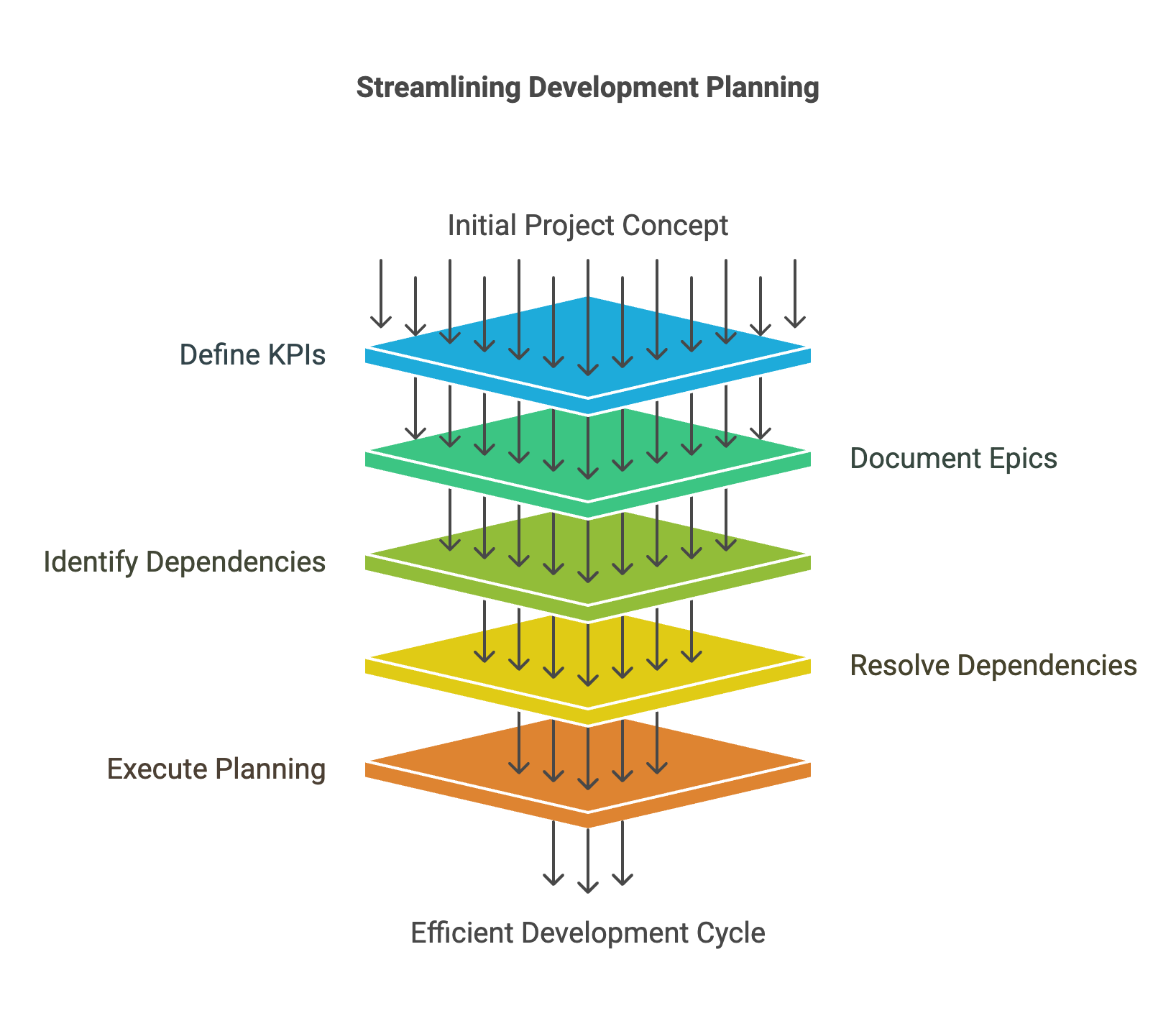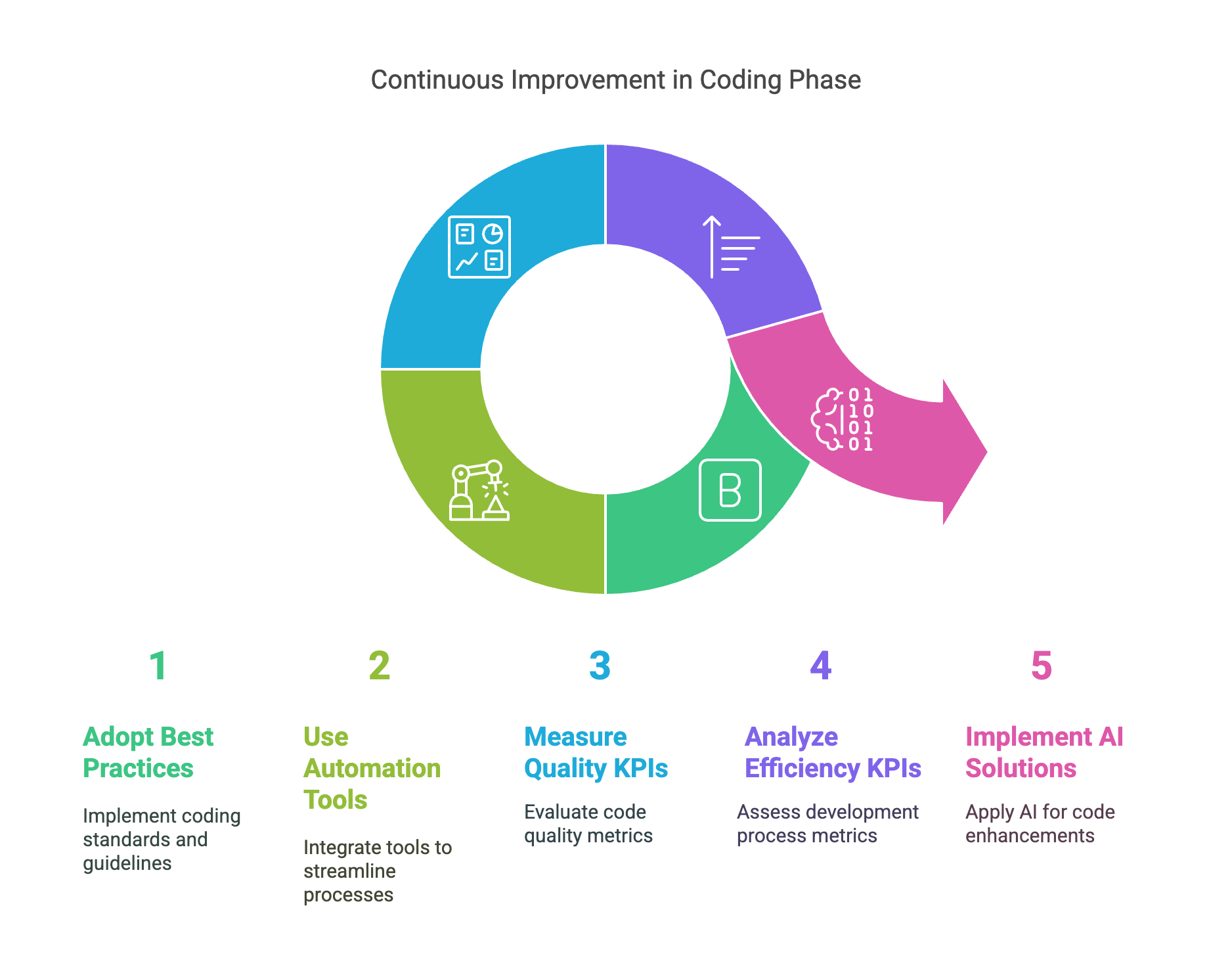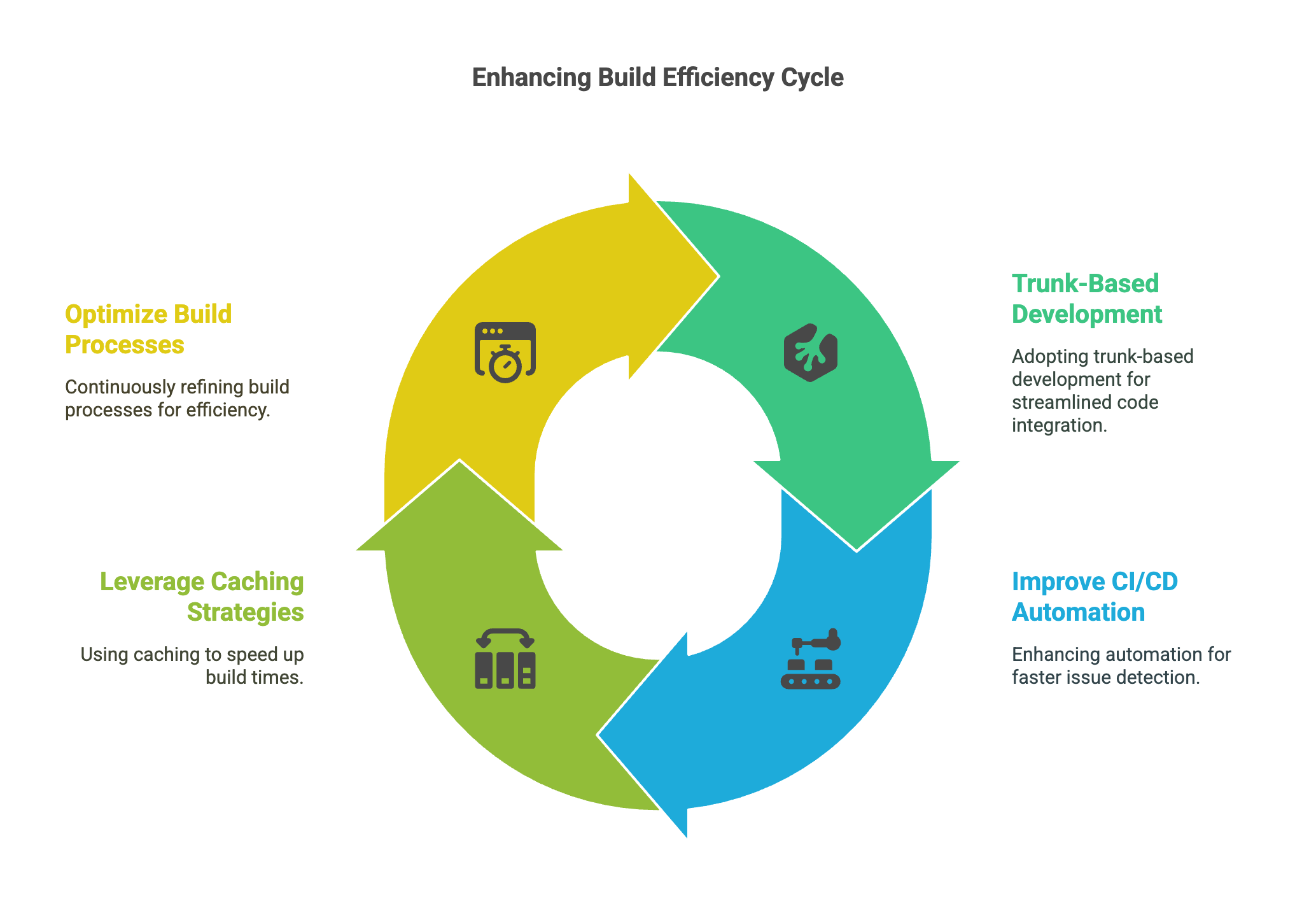Productivity KPIs in SDLC: Balancing Quality and Efficiency

In modern software development, measuring productivity is critical to ensuring high-quality output while maintaining speed and efficiency. However, productivity should not be assessed in isolation—quality and efficiency must be balanced to create sustainable engineering practices.
At the core of Software Development Lifecycle (SDLC) Productivity KPIs, two fundamental dimensions emerge:
- Quality KPIs – ensuring robust, reliable, and maintainable software.
- Efficiency KPIs – optimizing speed, automation, and developer throughput.

By tracking these two aspects across different stages of SDLC, engineering teams can drive continuous improvement and deliver better software faster.
Measuring Productivity Across the SDLC Stages

1. Planning Phase: Laying a Strong Foundation
Effective planning is the cornerstone of a well-executed development cycle. Without a solid plan, projects are prone to scope creep, delays, and inefficiencies.
- Quality KPIs
- Planning Accuracy – Measures the percentage of planned work that remains unchanged throughout the cycle. A high percentage indicates strong alignment and execution.
- Epic Coverage – Ensuring all epics are well-documented with UX/UI considerations and technical details before development begins. Properly structured epics reduce rework and unexpected scope changes.
- Dependency Identification – How well dependencies between teams, components, and features are identified early in the cycle.
- Efficiency KPIs
- Lead Time for Planning – The time taken to complete planning activities from ideation to approval. Shorter times suggest an efficient decision-making process.
- Dependency Resolution Time – The duration required to resolve cross-team dependencies before development starts. Efficient resolution prevents bottlenecks in later stages.
- Sprint Forecasting Accuracy – The percentage of work completed vs. planned within a sprint cycle.

🔹 Key Insight: Efficient planning reduces last-minute changes and delays while improving the predictability of development cycles. AI-driven planning tools and better cross-team collaboration can streamline this phase.
Where AI can help with the planning phase?
- Automated code documentation: Leveraging AI to automatically generate and update code documentation ensures clarity, consistency, and reduced manual effort, helping teams stay aligned and maintain accurate project documentation.
- Technical specification and task breakdown generation: AI can analyze project requirements to automatically create detailed technical specifications and break down complex tasks into manageable components, significantly reducing manual overhead and improving accuracy.
- AI-driven architectural recommendations: AI-powered tools analyze project goals, requirements, and past performance data to recommend optimal system architectures. This enables teams to proactively address potential design issues and improve scalability and maintainability.
- Smart data modeling suggestions: Utilizing AI algorithms, intelligent data modeling tools provide recommendations for database schema designs, data normalization strategies, and optimization techniques, enhancing overall database performance, scalability, and maintainability, thus facilitating faster query processing and efficient data handling.
2. Coding Phase: Speed and Maintainability
The coding phase determines the foundation of software quality and development speed. Adopting best coding practices, automation, and AI tools can significantly enhance productivity.
- Quality KPIs
- PR Size – Smaller pull request (PR) sizes (<100 lines) improve code review efficiency and maintainability.
- Rework Rate – The percentage of code that requires rework due to poor quality or failed reviews. Lower rates indicate better initial code quality.
- KTLO (Keep the Lights On) Work Percentage – Measures the proportion of development time spent on fixing existing issues rather than new feature development. Lower KTLO percentages mean a more stable codebase.
- Code Review Effectiveness – Measures the percentage of PRs requiring minimal changes post-review.
- Efficiency KPIs
- Merge Frequency – The number of PRs merged per developer per week. Higher frequencies indicate a smoother development process.
- PR Pickup Time – The time taken from PR creation to first review. Faster pickup times ensure timely feedback and iteration.
- PR Review Time – The duration required for PR reviews. Optimized review processes reduce cycle time.
- Automated Code Fixes Usage – Percentage of PRs improved by AI or automated tools.

🔹 Key Insight: AI-driven tools, automated code reviews, and clear coding standards improve both efficiency and quality at this stage. Teams that leverage AI-assisted code generation and auto-suggestions see up to a 30% improvement in development speed.
Where AI can help with the coding phase?
- AI pair programming for real-time code assistance: AI-powered pair programming tools provide developers with immediate code suggestions, examples, and debugging assistance during coding, significantly reducing development time, errors, and promoting best coding practices.
- Automated code reviews and quality checks: AI-driven code review systems automatically identify potential issues, security vulnerabilities, or deviations from coding standards, thereby enhancing code quality and speeding up the review process.
- Smart code completion and refactoring suggestions: AI-based smart completion tools predict and automatically suggest optimal code snippets and refactoring strategies, improving developer productivity, reducing redundancy, and enhancing code maintainability.
- Intelligent code reuse recommendations: Leveraging AI to identify existing reusable code components encourages efficient use of resources, decreases redundant work, and promotes consistency and maintainability throughout the software project.
3. Build Phase: Speeding Up the Feedback Loop
Build efficiency impacts how quickly teams receive feedback on code quality. Continuous integration and fast build pipelines are essential for maintaining productivity.
- Quality KPIs
- Build Success Rate – The percentage of successful builds. High rates indicate stability in the CI/CD pipeline.
- Failed Deployment Rate – The percentage of builds that fail during deployment, impacting release timelines.
- Dependency Resolution Errors – The number of build failures due to missing or incorrect dependencies.
- Efficiency KPIs
- Checkout Step Time – The time required to fetch and check out code. Faster times reduce waiting periods.
- Build Step Time – The time required to compile and bundle code. Efficient builds contribute to faster development cycles.
- Full Build Duration – The total time from triggering a build to completion. Optimized pipelines reduce downtime.
- CI/CD Automation Effectiveness – Measures how well automated pipelines detect and resolve issues.

🔹 Key Insight: Moving to trunk-based development, improving CI/CD automation, and leveraging caching strategies can significantly reduce build times.
Where AI can help with the build phase?
- Smart caching strategies & artifact management: AI-driven systems intelligently manage build artifacts and implement smart caching techniques, significantly reducing build times and improving overall efficiency.
- Predictive build failure detection: Using historical data, AI predicts potential build failures, allowing teams to proactively address issues before they occur, thus minimizing downtime and increasing reliability.
- Build failure pattern detection: AI identifies recurring patterns in build failures, helping teams quickly pinpoint root causes and streamline resolution processes.
- Infrastructure as code optimization: AI-driven analysis suggests optimal infrastructure configurations, enhancing stability, reducing costs, and improving overall performance.
- Dynamic environment provisioning: AI automates the provisioning of development and testing environments dynamically, reducing manual intervention, improving resource utilization, and enabling rapid scalability.
4. Testing Phase: Reducing Escaped Defects
Testing is critical in ensuring the stability and reliability of a product. Efficient testing practices prevent costly defects from reaching production.
- Quality KPIs
- Test Success Rate – The percentage of test cases that pass without failures, indicating overall test reliability.
- Use Case Coverage – The percentage of functional test coverage across user scenarios, ensuring robustness.
- Escaped Bug Count – The number of defects found post-release, indicating test effectiveness.
- Test Reliability – Percentage of test runs that provide consistent results.
- Efficiency KPIs
- Unit Test Execution Time – The time taken to run unit tests. Optimized times prevent delays in CI/CD pipelines.
- E2E Test Execution Time – The time taken for full end-to-end test runs. Parallel execution improves efficiency.
- Automated Test Percentage – Measures the ratio of automated vs. manual tests.

🔹 Key Insight: Parallel testing, automated test generation, and self-healing test suites reduce test execution time and improve stability.
Where AI can help with the testing phase?
- AI assisted test case generation: AI algorithms automatically generate comprehensive test cases based on requirements, code structures, and previous defect histories, significantly improving test coverage and accuracy.
- Smart test selection and prioritization: AI intelligently selects and prioritizes test cases that have the highest likelihood of identifying defects, optimizing test efforts, and shortening test cycles.
- Automated bug detection and prediction: Leveraging historical bug data, AI proactively identifies areas prone to defects, enabling teams to address potential issues early and enhance software quality.
- Self-healing test infrastructure: AI-driven self-healing mechanisms automatically diagnose, repair, and recover from test failures, ensuring consistent test execution and minimizing manual intervention.
- Continuous integration optimization: AI enhances continuous integration processes by optimizing test execution scheduling, resource allocation, and identifying bottlenecks, thereby accelerating development cycles and improving software reliability.
Final Thoughts: A Balanced Approach to SDLC Productivity
The key to optimizing SDLC productivity lies in balancing efficiency with quality. Over-indexing on efficiency can lead to increased technical debt, while overemphasizing quality may slow down development.

By continuously measuring and improving KPIs across the SDLC, organizations can create high-performing engineering teams that deliver both speed and reliability.
Leveraging AI across all SDLC phases enhances accuracy, automates repetitive tasks, proactively addresses potential issues, accelerates development cycles, and significantly elevates the overall efficiency and effectiveness of software engineering processes.


Comments ()